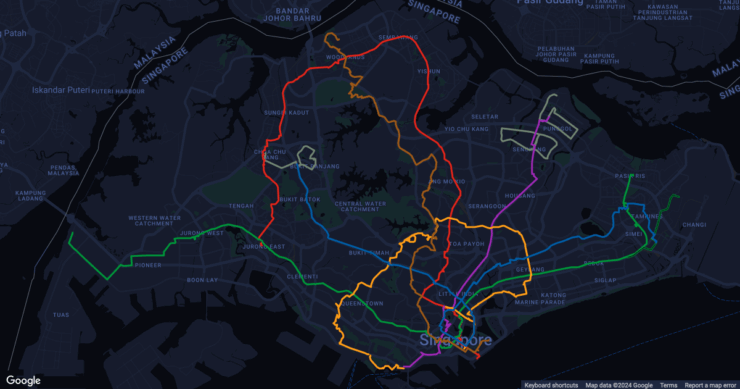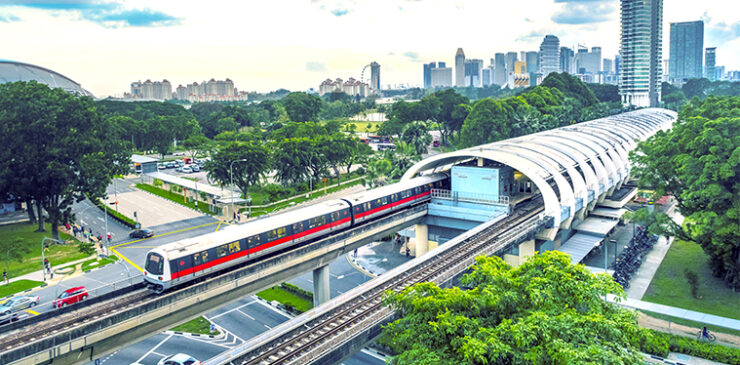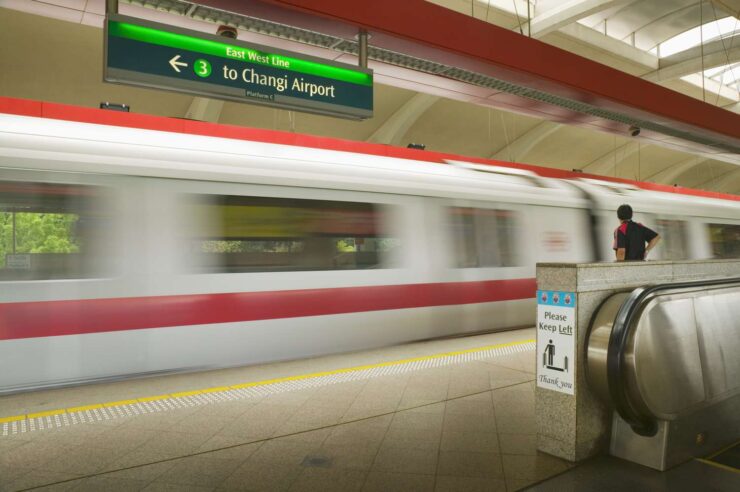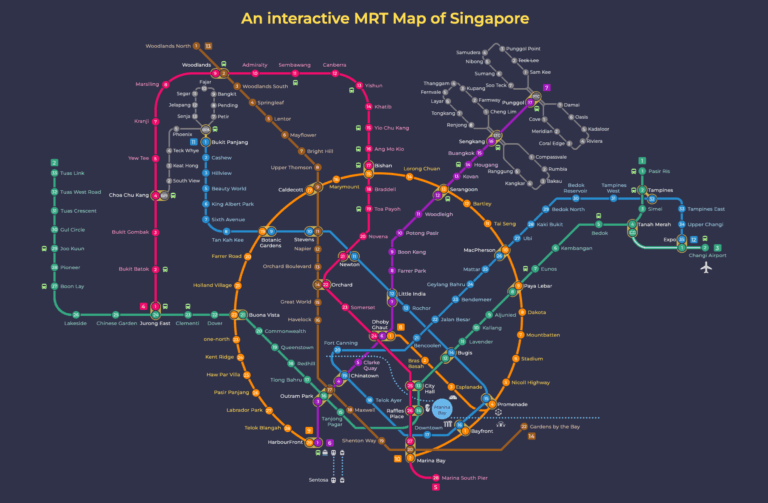Singapore’s daily rhythm is powered by a transport system that feels almost invisible in its efficiency. The MRT (Mass Rapid Transit) is more than just a collection of underground tunnels and elevated tracks – it’s a living network that moves millions without fuss, keeping the city-state running on time.
In a place where precision and convenience are highly valued, the MRT doesn’t just carry passengers; it transforms how people live, work, and connect.
Table: Overview of MRT Lines in Singapore
| MRT Line | Color (Map) | Approx. Length | Key Areas Covered | Notable Route Highlights |
| North-South Line (NSL) | Red | ~45 km | Runs north–south from Jurong East through Orchard, City Hall, to Marina Bay and Woodlands | Connects residential heartlands (Yishun, Ang Mo Kio) with CBD and shopping belts |
| East-West Line (EWL) | Green | ~57 km | Extends east–west from Pasir Ris/Changi Airport through Tampines, Bugis, to Jurong West/Tuas | One of the longest lines, links Changi Airport to city and western industrial zones |
| North-East Line (NEL) | Purple | ~20 km | From Punggol through Serangoon, Little India, Dhoby Ghaut, to HarbourFront | Fully automated; connects northeast housing estates with central and southern Singapore |
| Circle Line (CCL) | Orange | ~35 km (circular) | Loops through Bishan, Holland Village, Buona Vista, Paya Lebar, HarbourFront | Intersects almost all other lines; enhances cross-island connectivity |
| Downtown Line (DTL) | Blue | ~42 km | From Bukit Panjang through Little India, Bugis, Chinatown, to Expo | Serves Bukit Timah education belt and CBD; cuts travel time for eastern commuters |
| Thomson–East Coast Line (TEL) | Brown | Planned ~43 km (partially open) | Runs north (Woodlands) through Orchard, Marina Bay, to eastern coast (Bedok, Siglap, Sungei Bedok) | Still expanding; will eventually connect far north with east coast lifestyle hubs |
| Jurong Region Line (JRL) (under construction) | Light Green | ~24 km (expected 2029) | Serves Jurong Lake District, Tengah, NTU | Designed to support western industrial and residential growth |
| Cross Island Line (CRL) (under construction) | Light Blue | ~50 km (phased opening 2030s) | Crosses Singapore east–west, linking Changi to Jurong | Will be the longest line; designed to ease congestion on EWL |
The Everyday Reliability of MRT
One of the most striking things about the MRT is how ordinary it feels to those who use it daily. That sense of normalcy is exactly its triumph. Trains come on time, platforms are clearly marked, and there’s little second-guessing about how to get where you need to be. In a city where people balance work, school, and family on tight schedules, reliability is priceless.
This consistency changes how residents plan their days. A professional knows exactly how long it will take to reach a morning meeting in the CBD. Parents can confidently plan school drop-offs without factoring in unexpected delays. For tourists, it means seeing more of Singapore in a single day without worrying about transport mishaps.
How Stations Anchor Communities

The MRT isn’t just about movement; it’s about shaping neighborhoods. Urban planners have deliberately positioned stations as gateways into daily life. Step out of most stations, and you’re immediately inside a shopping mall, next to a hawker center, or within walking distance of schools and offices.
Take upcoming developments like Penrith. Living near an MRT stop doesn’t just mean convenience—it means your entire lifestyle is structured around accessibility. Daily commutes become shorter, errands easier, and weekend plans less of a logistical challenge. In Singapore, proximity to the MRT is more than a perk—it’s a way of life.
- Lifestyle made simple: When grocery runs, dining options, and banking services are all tied to MRT-linked complexes, daily routines shrink in effort.
- Property value uplift: Homes near stations naturally hold stronger long-term appeal, not just for resale but for comfort of living.
- Social hubs: Stations double as meeting points, where colleagues, friends, or family naturally converge.
The Reach Across the Island

For a relatively small nation, Singapore’s MRT system feels vast. Lines span from Changi Airport in the east to Jurong in the west, and from Woodlands in the north down to Marina Bay in the south. This reach is what allows people to live farther from the central core without sacrificing time.
The network’s design is intuitive. Transfers are efficient, with interchanges laid out in ways that minimize walking. For travelers new to Singapore, this makes the system remarkably approachable—no complex route maps to puzzle over, just a clean and direct path from one place to another.
Here’s what stands out about the MRT’s coverage:
- Island-wide access: Even less central areas are no more than a few stops away from major districts.
- Direct airport connection: Few cities make arriving by plane as stress-free as Singapore, where you can board an MRT straight from Changi.
- Tourist-friendly design: Major attractions like Orchard Road, Chinatown, and Gardens by the Bay all have stations nearby, making sightseeing efficient and affordable.
Comfort as Part of the Journey
What elevates the MRT beyond pure functionality is how it blends comfort into the ride. Trains are modern and air-conditioned, a welcome respite in Singapore’s tropical climate. Stations are clean, brightly lit, and thoughtfully designed with accessibility in mind.
Importantly, the system is designed for inclusivity. Escalators, elevators, and tactile floor paths ensure that seniors, parents with strollers, and people with disabilities can move as freely as anyone else. Announcements in multiple languages, along with digital signage, further reduce barriers for both locals and visitors.
That attention to comfort doesn’t just make the MRT pleasant—it reinforces why so many people prefer it over driving or taxis.
How Connectivity Shapes Opportunity
Singapore’s MRT also fuels economic opportunity. Businesses located near stations benefit from steady streams of customers. Job seekers expand their employment options because workplaces across the island become realistically accessible.
A strong example of this connectivity can be seen with projects like Skye at Holland, where proximity to MRT stations elevates the appeal of living and working in that area. When transit is simple, entire districts gain new vibrancy, turning into hotspots for both commerce and community life.
Think of the ripple effects:
- Small businesses around stations thrive on commuter traffic.
- Large companies can attract talent from wider geographic areas.
- Residents no longer need to choose between affordability and accessibility when selecting where to live.
A Benchmark for Global Transit Systems
It’s not uncommon for visitors from other cities to compare their metro systems to Singapore’s—and many find theirs wanting. The MRT’s reputation as a global standard comes from years of fine-tuning: constant expansion, safety-first design, and forward-looking policies.
- Technology integration: Contactless payment options and mobile apps streamline the experience.
- Safety measures: Platform screen doors, clear emergency signage, and active monitoring create trust among commuters.
- Expansion mindset: New lines and stations continue to roll out, ensuring the network grows alongside population needs.
This is why other urban planners often study Singapore’s system as a case study in effective public transport design.
The Cultural Layer of Commuting
Beyond speed and efficiency, the MRT has also woven itself into Singapore’s cultural landscape. Each station reflects its surroundings in subtle ways. Bras Basah station, for instance, lets natural light flood in, creating an open, airy atmosphere. Chinatown station highlights the heritage of its neighborhood, making it both a practical stop and a cultural marker.
These touches matter more than most people realize. They make the MRT more than a utility—it becomes part of the city’s identity, giving commuters a sense of belonging as they move through their day.
Why Commuting Feels Effortless
What truly makes the MRT stand out is how little thought it demands from its users. You don’t have to plan buffer times for traffic, you don’t worry about missed buses, and you don’t waste energy on logistics. Instead, you step onto a train and know you’ll get where you’re going on time.
That effortless flow is what makes commuting across Singapore both simple and fast. It’s not just infrastructure—it’s trust built into everyday routines.
Conclusion

Singapore’s MRT system is more than a transport network; it’s a cornerstone of how the city functions. By blending reliability, coverage, comfort, and cultural integration, it has turned daily commuting into something seamless. For residents, it means less stress and more time. For visitors, it offers freedom to explore with confidence. And for the city itself, it’s a vital force driving both economic growth and community connection.
If you’ve ever stepped onto an MRT platform in Singapore, you’ve experienced how a city can move millions with grace and speed. That’s the quiet genius of the MRT—it doesn’t just get you from place to place. It makes commuting across Singapore truly simple and fast.

